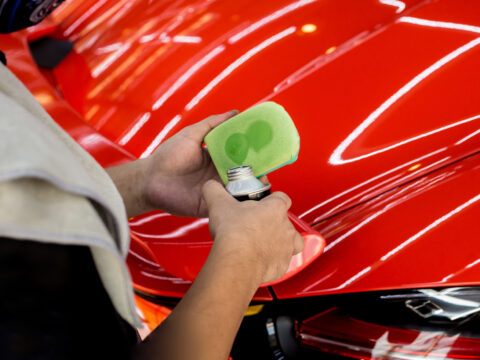A stylish, sleek car is not only a symbol of status but a reflection of its owner’s personality. For instance, bright colors such as red and yellow are often associated with bold personalities, while cool shades like silver and gray represent elegance and sophistication. However, choosing the right color for your car becomes more critical in hot weather.
It’s not just about personal preference; some colors can keep you cooler and protect your vehicle from heat damage. So, let’s dive into the world of car paint colors and discover which ones are the best for hot weather.

Contents
Does the Color of Your Car Really Make a Difference in Hot Weather?
Yes, the color of your car can make a significant difference in the hot weather, as it can affect both the temperature inside the vehicle and the car’s exterior.
Darker colors, such as black and dark blue, absorb more heat from the sun, making the car’s interior feel like an oven. It can also cause the paint to fade and reduce the vehicle’s longevity. Conversely, lighter colors such as white and silver reflect more sunlight, which can keep the car cooler and protect it from the harmful effects of the sun’s UV rays.
What Studies Say About Car Paint Colors and Hot Weather
A recent research study at Berkeley Lab’s Environmental Energy Technologies Division found that silver or white cars can be up to 10°F cooler than black cars when parked under direct sunlight. This is attributable to their high reflectivity levels, as they reflect about 60% of incoming sunlight as opposed to only 5% for black vehicles.
This study demonstrates that the color of your car’s exterior can significantly determine its internal temperature during hot weather. Choosing lighter car colors helps keep your vehicle cooler and potentially reduce the need for air conditioning, ultimately saving energy and money on fuel costs.
So, What Car Paint Colors are Best for Hot Weather?
Light-colored cars are the best option as they reflect heat and sunlight better than dark colors. Here is a breakdown of the colors you can consider for your car during hot weather:
- White – White is a popular choice among drivers living in hot climates because it reflects the most sunlight of any color. It also hides dirt and scratches well, making it easy to maintain. However, if you live in a dusty area, you may want to avoid white as it can easily show dirt, which is common in hot weather.
- Silver – Silver has a higher spectral reflectance than any other color, reflecting up to 95% of sunlight. This property keeps the car cooler by preventing excess heat absorption. This color is also sleek and sophisticated, ideal for luxury cars.
- Beige – Beige combines a light color with a warm tone, making it an excellent choice for hotter climates. The earthy and neutral tone of beige reflects UV rays, effectively ensuring your car exterior and interior remain cool. It’s also a calming color, perfect for those who want a more refined look for their car.
- Light Blue – Light blue reflects sunlight and has a cool, refreshing look. It’s not as common color as white or silver, making it stand out. It also gives a relaxed and carefree vibe, perfect for a summer beach trip or a coastal drive.
Tinted windows can further help keep your car cool by reducing the amount of sunlight that enters the cabin.

And, here are the worst car colors for hot weather
Here’s a list of the four worst car colors for hot weather:
- Black – Black cars absorb more heat from sunlight than any other color. This is because black surfaces have low solar spectral reflectance and tend to retain heat longer.
- Navy Blue – These colored cars may not get as warm as black cars but still contribute to higher cabin air temperatures than light-colored vehicles.
- Burgundy – This color absorbs more sunlight and retains it longer, making the interior warmer on sunny days.
- Brown – Brown might seem like a neutral choice when it comes to car paint colors; however, its ability to absorb and retain heat makes it less suitable for hotter climates.
If your car already has these bright colors, you can park your vehicle in shaded areas whenever possible to minimize direct sunlight exposure.
Is the Car Interior Color Also Affected by Hot Weather?
Yes, the color of your car’s interior can also be affected by hot weather. It can cause the upholstery and dashboard materials to absorb heat and become significantly warmer, making it uncomfortable for the driver and passengers.
Hot weather can also reduce the lifespan of the car interior materials, leading to cracking and fading over time. Therefore, using lighter and reflective materials for car interiors is ideal to ensure a cooler and more comfortable ride during hot weather. Light-colored leather seats, for example, can reduce the surface temperature of the seats.
What Car Color Fades the Slowest in Sunlight?
When it comes to car paint colors, not all of them are created equal. Some colors fade faster than others when exposed to sunlight for extended periods. Choosing a color that resists fading can help maintain your vehicle’s appearance and resale value over time.
Here is a list of colors that fade slowest in sunlight:
- Silver
- White
- Grey
- Red
It is important to note that fading is also affected by external factors such as the quality of the paint job and the environment the car is driven and parked.
Important Tips When Choosing Car Color
When deciding on a car paint color, practicality, and longevity should be considered in addition to visual appeal. Here are essential tips to consider when selecting a car paint color:
- Consider your location’s climate: If you live in a hot region, opt for lighter colors like white or silver that can help keep your vehicle cooler. If in colder climates, darker hues may be preferable as they can absorb more heat.
- Evaluate maintenance requirements: Some colors show dirt and scratch more easily than others. Ensure you choose a color that suits your lifestyle and willingness to maintain its appearance.
- Consider resale car value – Neutral colors like black, white, and silver have higher resale values than bright or unusual colors.
- Consider usage rate – If a car is regularly on the road choosing colors that fade slowly, it is crucial to maintain the exterior.
Considering all these aspects, you can pick the optimal car paint color that both pleases your eye and offers advantages such as temperature regulation, care needs, resale worthiness, and UV ray resistance.














